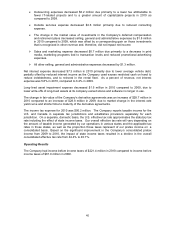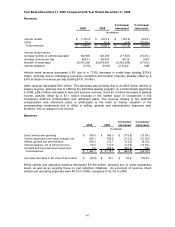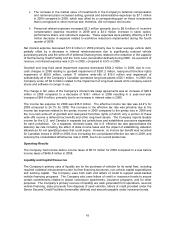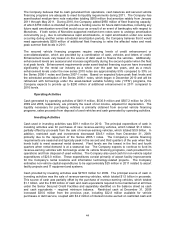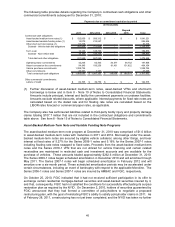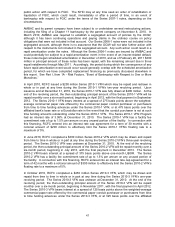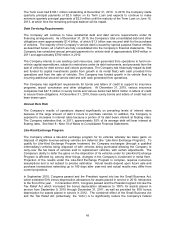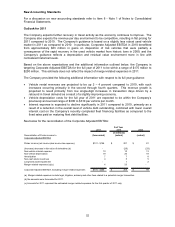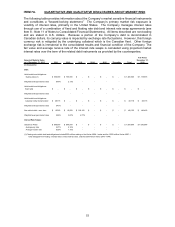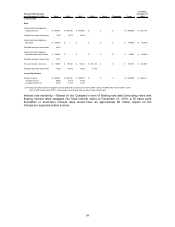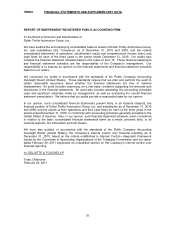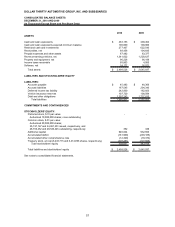Thrifty Car Rental 2010 Annual Report Download - page 51
Download and view the complete annual report
Please find page 51 of the 2010 Thrifty Car Rental annual report below. You can navigate through the pages in the report by either clicking on the pages listed below, or by using the keyword search tool below to find specific information within the annual report.income taxes for the years affected and to result in a refundable overpayment of 2010 federal tax
amounts deposited prior to the enactment of the Acts. The Company expects to fully recover these
overpayments in 2011 through cash refunds and offsets to potential 2011 federal income taxes
payable. Increased cash tax payments may be incurred in the future, depending on future vehicle
purchase and sale transactions and the continuations of laws affecting bonus depreciation.
The Like-Kind Exchange Program has historically increased the amount of cash and investments
restricted for the purchase of replacement vehicles, especially during seasonally reduced fleet
periods. At December 31, 2010, restricted cash and investments totaled $277.4 million and are
restricted for the acquisition of revenue-earning vehicles and other specified uses as defined under
asset-backed financing programs, the Canadian fleet securitization partnership program and the
Like-Kind Exchange Program. The majority of the restricted cash and investments balance is
normally utilized in the second and third quarters for seasonal purchases.
Inflation
The increased acquisition cost of vehicles is the primary inflationary factor affecting the Company.
Many of the Company’s other operating expenses are also expected to increase with inflation.
Management does not expect that the effect of inflation on the Company’s overall operating costs will
be greater for the Company than for its competitors. Inflation did not have a material impact on the
Company’s results of operations for the three years in the period ended December 31, 2010.
Critical Accounting Policies and Estimates
As with most companies, the Company must exercise judgment due to the level of subjectivity used
in estimating certain costs included in its results of operations. The more significant items include:
Revenue-earning vehicles and related vehicle depreciation expense – Revenue-earning
vehicles are stated at cost, net of related discounts. In 2010, the Company continued to
increase the level of Non-Program Vehicles in its fleet. At December 31, 2010, Non-Program
Vehicles accounted for approximately 98% of the total fleet.
For Non-Program Vehicles, the Company must estimate what the residual values of these
vehicles will be at the expected time of disposal to determine monthly depreciation rates.
The estimation of residual values requires the Company to make assumptions regarding the
age and mileage of the car at the time of disposal, as well as expected used vehicle auction
market conditions. The Company reevaluates estimated residual values periodically and
adjusts depreciation rates as appropriate. Differences between actual residual values and
those estimated by the Company result in a gain or loss on disposal and are recorded as an
adjustment to depreciation expense at the time of sale. Actual timing of disposal either
shorter or longer than the life used for depreciation purposes could result in a loss or gain on
sale. A one percent change in the expected residual value of Non-Program Vehicles sold
during 2010 would have impacted vehicle depreciation expense net by $5.9 million. The
average holding term for vehicles was approximately 18 to 20 months for 2010.
For Program Vehicles, the Company is required to depreciate the vehicle according to the
terms of the guaranteed depreciation or repurchase program and in doing so is guaranteed
to receive the full net book value in proceeds upon the sale of the vehicle. In some cases,
the sales proceeds are received directly from the auctions, with any shortfall in value being
paid by the vehicle manufacturer. With certain other vehicle manufacturers, the entire
balance of proceeds from vehicle sales comes directly from the manufacturer. In either
case, the Company bears the risk of collectability on that receivable from the vehicle
manufacturer. The Company monitors its vehicle manufacturer receivables based on time
outstanding, manufacturer strength and length of the relationship.
Vehicle insurance reserves – The Company self-insures or retains a portion of the exposure
for losses related to bodily injury and property damage liability claims along with the risk
50


